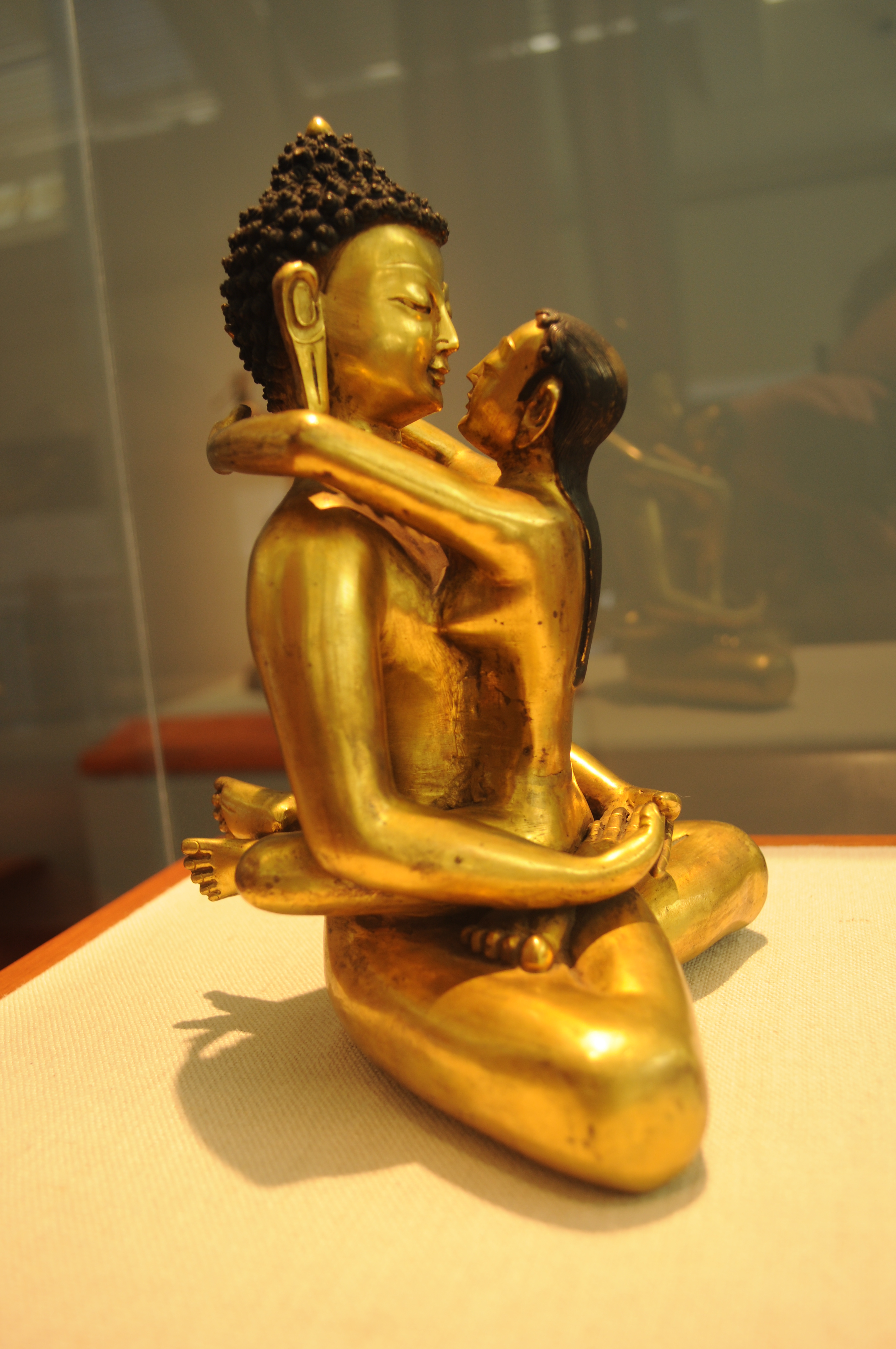Ground (Dzogchen) on:
[Wikipedia]
[Google]
[Amazon]
 In
In
 In the Longchen Nyingtik tradition, the ground has three qualities or aspects, also called the "three wisdoms". Each one is paired with one of the three bodies of the Buddha and with one of the three jewels (indicating that these are fully included in each sentient being). Norbu notes that "these three aspects are interdependent and cannot be separated from each other," just like the various qualities of a mirror are all essential to the existence of a mirror. The three aspects of the basis are:
In the Longchen Nyingtik tradition, the ground has three qualities or aspects, also called the "three wisdoms". Each one is paired with one of the three bodies of the Buddha and with one of the three jewels (indicating that these are fully included in each sentient being). Norbu notes that "these three aspects are interdependent and cannot be separated from each other," just like the various qualities of a mirror are all essential to the existence of a mirror. The three aspects of the basis are:
 *Essence (Tib. ངོ་བོ་, ''ngowo''; Wyl. ''ngo bo'', Skt. ''
*Essence (Tib. ངོ་བོ་, ''ngowo''; Wyl. ''ngo bo'', Skt. ''
 In
In Dzogchen
Dzogchen (, "Great Perfection" or "Great Completion"), also known as ''atiyoga'' ( utmost yoga), is a tradition of teachings in Indo-Tibetan Buddhism and Yungdrung Bon aimed at discovering and continuing in the ultimate ground of existence ...
, the ground or base () is the primordial state. It is an essential component of the Dzogchen tradition for both the Bon tradition and the Nyingma
Nyingma (literally 'old school') is the oldest of the four major schools of Tibetan Buddhism. It is also often referred to as ''Ngangyur'' (, ), "order of the ancient translations". The Nyingma school is founded on the first lineages and transl ...
school of Tibetan Buddhism
Tibetan Buddhism (also referred to as Indo-Tibetan Buddhism, Lamaism, Lamaistic Buddhism, Himalayan Buddhism, and Northern Buddhism) is the form of Buddhism practiced in Tibet and Bhutan, where it is the dominant religion. It is also in maj ...
. Knowledge of this ''ground'' is called ''rigpa
In Dzogchen, ''rigpa'' (; Skt. vidyā; "knowledge") is knowledge of the ground. The opposite of ''rigpa'' is ''ma rigpa'' ('' avidyā'', ignorance). A practitioner who has attained the state of ''rigpa'' and is able to rest there continuously ...
''.
Explication
A key concept in Dzogchen is the 'basis', 'ground' or 'primordial state' (Tibetan: གཞི་ ''gzhi''), also called the general ground (སྤྱི་གཞི་ ''spyi gzhi'') or the original ground (གདོད་མའི་གཞི་ ''gdod ma'i gzhi''). The basis is the original state "before realization produced buddhas and nonrealization produced sentient beings". It is atemporal and unchanging and yet it is "noetically potent", giving rise to mind (སེམས་ ''sems,''), consciousness (ཤེས་པ་ ''shes pa''), delusion (མ་རིག་པ་ ''marigpa'') and knowledge (རིག་པ་་''rigpa
In Dzogchen, ''rigpa'' (; Skt. vidyā; "knowledge") is knowledge of the ground. The opposite of ''rigpa'' is ''ma rigpa'' ('' avidyā'', ignorance). A practitioner who has attained the state of ''rigpa'' and is able to rest there continuously ...
''). Furthermore, Hatchell notes that the Dzogchen tradition portrays ultimate reality as something which is "beyond the concepts of one and many."
Thus in Dzogchen, the basis is a pure empty consciousness which is what needs to be recognized to achieve awakening. According to Smith, ''The Illuminating Lamp'' declares that in Ati Yoga, pristine consciousness is a mere consciousness that apprehends primordial liberation and the generic basis as the ultimate." In other words, spiritual knowledge in Dzogchen is recognizing one's basis.
Since the basis transcends time, any temporal language used to describe it (such as "primordial", "original" and so on) is purely conventional and does not refer to an actual point in time, but should be understood as indicating a state in which time
Time is the continued sequence of existence and events that occurs in an apparently irreversible succession from the past, through the present, into the future. It is a component quantity of various measurements used to sequence events, t ...
is not a factor. According to Smith, "placing the original basis on a temporal spectrum is therefore a didactic myth
Myth is a folklore genre consisting of narratives that play a fundamental role in a society, such as foundational tales or origin myths. Since "myth" is widely used to imply that a story is not objectively true, the identification of a narrati ...
."
The basis also is not to be confused with the "all-basis" (Tib. ཀུན་གཞི་ ''kun gzhi) or with the fundamental store consciousness (Tib. ཀུན་གཞི་རྣམ་པར་ཤེས་པ་ ''kun gzhi rnam par shes pa''), since these are both samsaric modes of consciousness. Other terms used to describe the basis include unobstructed (མ་འགགས་པ་ ''ma 'gags pa''), universal (ཀུན་ཁྱབ་ ''kun khyab'') and omnipresent.
The basis is also associated with the term '' Dharmatā'', defined as follows: "Dharmatā, original purity, is free from all proliferation. Since it is unaffected by ignorance, it is free from all obscurations." According to Smith, describing the basis as “great original purity” (ཀ་དག་ཆེན་པོ་ ''ka dag chen po'') is the only description which is held to be flawless according to various Dzogchen Tantras.
The basis is also associated with the primordial or original Buddhahood, also called Samantabhadra, which is said to be beyond time and space itself. Hence, Buddhahood is not something to be gained, but it is an act of recognizing what is already immanent in all sentient beings. This view of the basis stems from the Indian Buddha-nature
Buddha-nature refers to several related Mahayana Buddhist terms, including '' tathata'' ("suchness") but most notably ''tathāgatagarbha'' and ''buddhadhātu''. ''Tathāgatagarbha'' means "the womb" or "embryo" (''garbha'') of the "thus-go ...
theory according to Pettit. Tibetan authors like Longchenpa and Jigme Lingpa specifically linked the Dzogchen view of the basis with Buddha-nature or ''sugatagarbha'' (especially as it is found in the '' Ratnagotravibhāga'').
In Vimalamitra
In the ''Great Commentary'' of Vimalamitra (8th century), the basis is defined as "one’s unfabricated mind" (''rang sems ma bcos pa''). As Smith notes, this indicates how the basis is not some transpersonal entity. The basis is therefore not defined as being "one thing" (i.e. monism, Brahman etc.), since there exists the production of diversity. Regarding this, '' The Realms and Transformations of Sound Tantra'' states: "Other than compassion arising as diversity, it is not defined as one thing." The ''Illuminating Lamp'' commentary explains the pristine consciousness of the basis thus:In Longchenpa
The Tibetan master Longchenpa (1308–1364) describes the basis as follows: Moreover, Longchenpa notes that "ground" should be understood as a "groundless ground", which seems to be a ground and is posited as so only from a relative perspective, while in the true nature of reality it is empty of being a ground. Because it has no intrinsic nature, and from the a relative perspective the experiences of saṃsāra and nirvāṇa seem to arise from it, it is referred to as the ground:In Namkhai Norbu
Namkhai Norbu (1938–2018) writes that the term basis denotes "the fundamental ground of existence, both at the universal level and at the level of the individual, the two being essentially the same." This basis is "uncreated, ever pure and, self-perfected, it is not something that has to be constructed," however it "remains hidden to the experience of every being affected by the illusion of dualism." Jean Luc-Achard defines the basis as "the actual, authentic abiding mode of the Mind." According to Achard, Dzogchen tantras define the basis as "Great Primordial Purity" (''ka dag chen po''). The ''Tantra of the Beautiful Auspiciousness'' (''bKra shis mdzes ldan gyi rgyud'') defines this as "the state abiding before authentic Buddhas arose and before impure sentient beings appeared."Three aspects
 In the Longchen Nyingtik tradition, the ground has three qualities or aspects, also called the "three wisdoms". Each one is paired with one of the three bodies of the Buddha and with one of the three jewels (indicating that these are fully included in each sentient being). Norbu notes that "these three aspects are interdependent and cannot be separated from each other," just like the various qualities of a mirror are all essential to the existence of a mirror. The three aspects of the basis are:
In the Longchen Nyingtik tradition, the ground has three qualities or aspects, also called the "three wisdoms". Each one is paired with one of the three bodies of the Buddha and with one of the three jewels (indicating that these are fully included in each sentient being). Norbu notes that "these three aspects are interdependent and cannot be separated from each other," just like the various qualities of a mirror are all essential to the existence of a mirror. The three aspects of the basis are:
 *Essence (Tib. ངོ་བོ་, ''ngowo''; Wyl. ''ngo bo'', Skt. ''
*Essence (Tib. ངོ་བོ་, ''ngowo''; Wyl. ''ngo bo'', Skt. ''svabhāva
Svabhava ( sa, स्वभाव, svabhāva; pi, सभाव, sabhāva; ; ) literally means "own-being" or "own-becoming". It is the intrinsic nature, essential nature or essence of beings.
The concept and term ''svabhāva'' are frequently enco ...
''). It is defined as original purity (Tib ''ka dag'', "ever-pure"). ''Ka dag'' is a contraction of ''ka nas dag pa,'' "pure from ka" (''ka'' is the first letter of the Tibetan alphabet) which is also glossed as pure from the beginning (''thog nas dag pa''). In this context, purity (Skt. '' śuddha'') refers to emptiness ('' śunyata'', ''stong pa nyid''), which in Dzogchen is explained in a similar way to how emptiness is explained in Madhyamaka
Mādhyamaka ("middle way" or "centrism"; ; Tibetan: དབུ་མ་པ ; ''dbu ma pa''), otherwise known as Śūnyavāda ("the emptiness doctrine") and Niḥsvabhāvavāda ("the no ''svabhāva'' doctrine"), refers to a tradition of Buddh ...
(as being free from the extremes of nihilism and eternalism). The "Essence" is also associated with the Dharmakaya and the Buddha. Namkhai Norbu explains this as the fact that all phenomena are "essentially void, impermanent, only temporarily existing, and all 'things' can be seen to be made up of other things." He compares this aspect with the emptiness which allows a mirror to take on any image.
*Nature (Tib. རང་བཞིན་, ''rangshyin''; Wyl. ''rang bzhin'', Skt. '' prakṛti'') is defined as "Natural Perfection" (Tib. ''lhun grub'', Skt. ''anābhoga''), also translated "spontaneous presence" or "spontaneous accomplishment". This is the noetic potentiality of the basis. According to Norbu, this aspect refers to the continuous manifestation or appearance of phenomena and can be illustrated by comparing it to a "mirror's capacity to reflect." Sam van Schaik
Sam Julius van Schaik is an English tibetologist.
Education
He obtained a PhD in Tibetan Buddhist literature at the University of Manchester in 2000, with a dissertation on the translations of Dzogchen texts by Jigme Lingpa.
Career
S ...
explains this as "a presence that is spontaneous in that it is not created or based on anything" as well as "the luminous aspect of the ground". Natural Perfection is also used interchangeably with the aspect of " luminosity" (''See also
* Seventeen tantras * Sky gazing *Trekchö
In Dzogchen, ''trekchö'' (''khregs chod'') means "(spontaneous) cutting of tension" or "cutting through solidity." The practice of ''trekchö'' reflects the earliest developments of Dzogchen, with its admonition against practice. In this practice ...
* Tögal
Notes
References
Citations
Works cited
* * * * * * * * * * * * *Further reading
* {{Buddhism topics Buddha-nature Dzogchen Tibetan Buddhist philosophical concepts